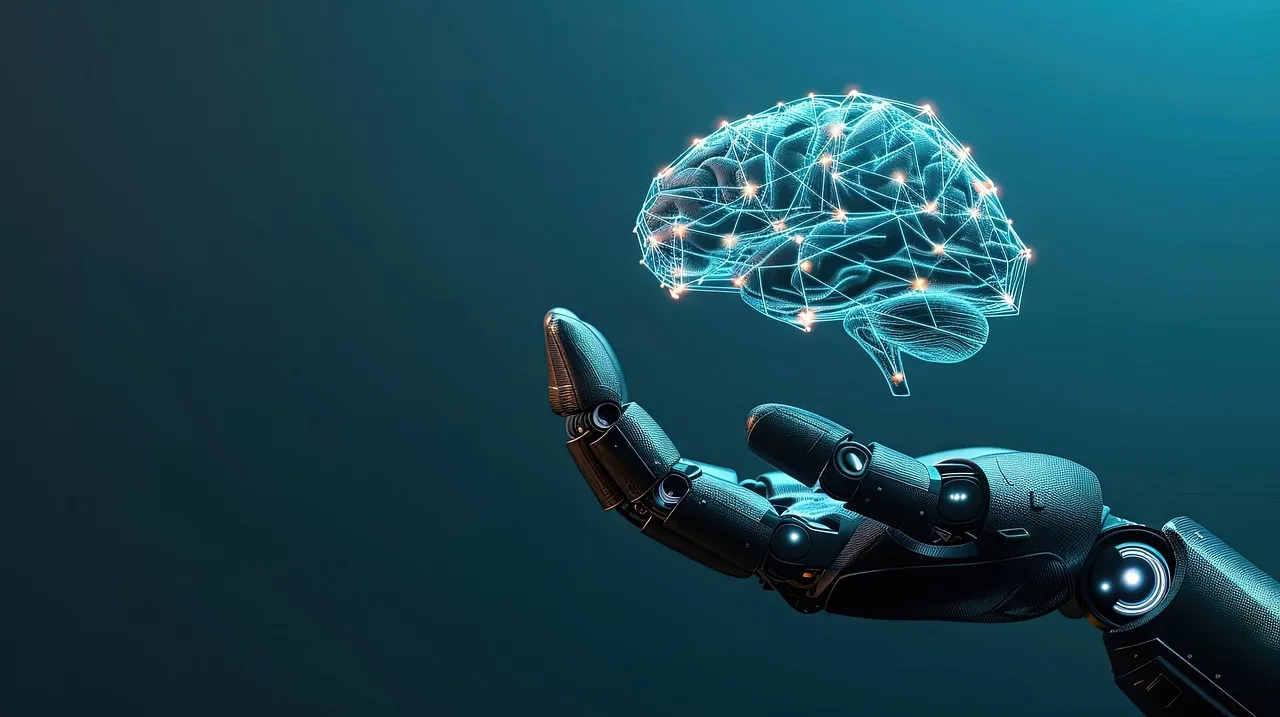Week 1
Machine Learning and Limitations
Question 1
Artificial Intelligence (AI) is only concerned with the designing and building of intelligent agents that receive precepts from the environment and discover patterns in that environment.
- True
- False
Question 2
Classification is what kind of machine learning?
- Regression
- Reinforcement learning
- Supervised learning
- Unsupervised learning
Question 3
During the inference phase, the parameters of the rules (or “model”) are updated automatically using one or more mathematical algorithms.
- True
- False
Question 4
Machine learning models are prone to biases in the data.
- True
- False
Question 5
Which of the following are good ways to build societal trust into an artificial intelligence (AI) system? Select all that apply.
- Robust
- Efficiency
- Ethical
- Lawful
Embedded Machine Learning
Question 1
A microcontroller is a powerful processing unit that relies on off-chip flash and RAM for computations and is often capable of running general-purpose operating systems, like Windows, macOS, and Linux.
- True
- False
Question 2
If a system is 99% accurate at detecting a spoken word, it is deterministic.
- True
- False
Question 3
Machine learning can be used to detect anomalies.
- True
- False
Question 4
All microcontrollers are capable of running machine learning.
- True
- False
Question 5
TinyML software frameworks optimize machine learning operations to allow embedded devices to run machine learning algorithms more quickly and efficiently.
- True
- False
Data Collection
Question 1
Which portion of the dataset is used to evaluate the model in order to fine-tune the model’s hyperparameters?
- Validation set
- Test set
- Common set
- Training set
Question 2
Which portion of the dataset is put aside until the very end to evaluate the model after training and hyperparameter tuning?
- Test set
- Training set
- Validation set
- Common set
Question 3
Which portion of the dataset is used to automatically update the model’s parameters?
- Common set
- Training set
- Test set
- Validation set
Question 4
A “naïve classifier” always predicts the same class every time it is run.
- True
- False
Question 5
What is a “balanced dataset?”
- A dataset where the input dimensions of the model are equal to the output dimensions.
- A dataset that contains approximately equal number of samples in the training, validation, and test sets.
- A dataset that contains samples with the same number of dimensions.
- A dataset that contains approximately equal number of samples in each class.
Feature Extraction
Question 1
What is a “feature” with regards to machine learning?
- A measurable property of something that’s observed
- A plot of the data over time
- A spectral analysis used to break apart the data into its various frequency components
- A description of the overall shape and trends in the data
Question 2
Feature extraction can be used to reduce the computational complexity of a machine learning model.
- True
- False
Question 3
What is “inference” with regards to machine learning?
- Automatically updating a model’s parameters with data
- Analyzing the data to determine which features to use
- Reducing the number of dimensions in features to reduce computational complexity.
- Using a trained model to make predictions with unseen data
Question 4
Hyperparameters are automatically updated during model training.
- True
- False
Question 5
You generally want to use different feature extraction methods between training and inference.
- True
- False
Machine Learning Overview
Question 1
All artificial intelligence (AI) is considered machine learning (ML).
- True
- False
Question 2
During the training phase, the parameters of the rules (“model”) are updated automatically using one or more mathematical algorithms.
- True
- False
Question 3
Machine learning can be used to identify objects in images.
- True
- False
Question 4
Ensuring data integrity and privacy is a key factor in building societal trust of AI systems.
- True
- False
Question 5
Which of the following would be appropriate uses of embedded machine learning? Select all that apply.
- Detecting anomalies in an online banking application
- Detecting anomalies in the servomotor of a satellite
- Performing an action based on a spoken keyword
- Identifying objects in an image
Question 6
The test set is used to evaluate the model in order to fine-tune the model’s hyperparameters.
- True
- False
Question 7
Using a balanced dataset can help you avoid training a naïve classifier.
- True
- False
Question 8
Which of the following would be considered a “feature” with regards to machine learning? Select all that apply.
- How long to train the model
- Raw data value
- The root mean square (RMS) value of all the data
- Prominent frequency values found in the data
Question 9
The process of extracting features from unseen data is known as “inference.”
- True
- False
Question 10
Machine learning models can learn biases found in data.
- True
- False
Week 2
Neural Networks and Training
Question 1
The activation function allows a perceptron (node) to act as a linear regression function.
- True
- False
Question 2
A single node in a neural network performs the following actions in order:
Multiplies each input value by a weight
Sums the products of step 1
Adds a bias term to the sum computed in step 2
Applies an activation function to the sum from step 3 to produce a single value output
- True
- False
Question 3
“Backpropagation” is the process of computing a prediction given an input sample and comparing the model’s prediction to that sample’s known label to calculate a loss value.
- True
- False
Question 4
Model parameters (weights and bias terms) are updated manually by the programmer during training.
- True
- False
Question 5
Performing forward and backward passes on the model with the entire data set is called what?
- An iteration
- A mini-batch
- Regression
- An epoch
Evaluation, Underfitting, and Overfitting
Question 1
You plot the training and validation loss over the training period of the model, and you see the following. What can we conclude about the model?
- The model’s input dimensions do not match the data’s dimensions
- The model has underfit to the training data
- The model has overfit to the training data
- The model model has a good fit with the training data
Question 2
Which of the following are good ways to try to reduce overfitting? Select all that apply.
- Add regularization terms
- Early stopping
- Use a more complex model
- Gather more data
Deploy Model to Embedded System
Question 1
The features you extracted during the training process must have the same number of dimensions as the features you extract during inference.
- True
- False
Question 2
Your machine learning model is a neural network that ends with the softmax function, and you have trained it to predict the label among 5 different classes. How many outputs does your model have?
- 1
- 3
- 5
- 10
Question 3
After performing inference, the outputs of the softmax function should always add up to 1.0.
- True
- False
Question 4
After performing inference, your model outputs 5 probabilities, each pertaining to the probability or confidence rating of each class. Finding the lowest probability will give you which class the model is predicting that the data belongs to.
- True
- False
Anomaly Detection
Question 1
You wish to identify the spoken keyword “Alexa.” An anomaly detection system is a good way to accomplish this task.
- True
- False
Motion Classification and Anomaly Detection
Question 1
The activation function provides a non-linear output of a single node in a neural network.
- True
- False
Question 2
Hyperparameters are updated automatically during the training process.
- True
- False
Question 3
The process of automatically updating a neural network’s parameters based on the calculated loss between the predicted label and actual label is known as a forward pass.
- True
- False
Question 4
You plot the training and validation accuracy over the training period of the model, and you see the following. What can we conclude about the model?
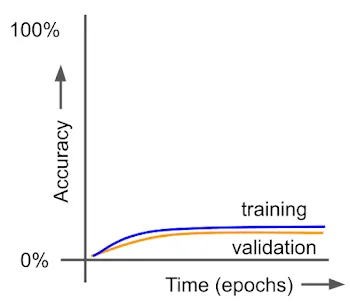
- The model has overfit to the training data
- The model has a good fit with the training data
- The model’s input dimensions do not match the data’s dimensions
- The model has underfit to the training data
Question 5
You are creating a motion classification system, and your feature extraction method includes calculating the root mean square (RMS) and the frequency value of the 3 highest peaks of the power spectral density (PSD) of each axis on a 3-axis accelerometer from a 10 millisecond sample period. How many dimensions should the input to your model be?
- 12
- 1
- 3
- 10
Question 6
You deploy your machine learning model to an embedded system. The model ends with the softmax function, giving you 4 outputs, one for each class. How do you find the predicted class?
- Sum the results, which will give you an index to the array of class labels
- Choose the class with the highest output value
- Average the results together, which will give you an index to the array of class labels
- Choose the class with the lowest output value
Question 7
The identification of rare events is known as anomaly detection.
- True
- False
Question 8
Gathering more data is one way to reduce overfitting.
-
- True
- False
Week 3
Audio Classification and Sampling Audio Signals
Question 1
Which of the following are good uses of audio classification? Select all that apply.
- Translating handwriting to computer-encoded text
- Tracking wildlife
- Identifying anomalous noises in a home or office
- Translating spoken words to computer-encoded text
Question 2
In a digital system, audio signals are sampled at a regular interval. A sampling period of 125 microseconds translates to a sampling rate of what?
- 44.1 kHz
- 48 kHz
- 8 kHz
- 16 kHz
Question 3
A sampled audio signal with a bit depth of 8 bits has more resolution than an audio signal with a bit depth of 16 bits.
- True
- False
MFCCs and CNNs
Question 1
You are creating a system to classify audio events whose maximum frequency is 10 kHz. Your sample rate needs to be at least what?
- 20 kHz
- 10 kHz
- 5 kHz
- 40 kHz
Question 2
Why do we use the Mel-frequency cepstral coefficients (MFCCs) as features for audio data?
- They provide data augmentation to help create a more robust audio classifier.
- They mimic how the human ear perceives sound.
- They mimic how the human vocal cords and mouth produce sound.
- They help prevent overfitting.
Question 3
What does a single node in a convolution layer of a convolutional neural network do?
- It prevents a random selection of outputs of the previous layer from reaching the next layer.
- It combines the outputs of the previous layer such that they each have a value between 0 and 1 and all sum to 1.
- It filters the image using a kernel.
- It slides a window over the image, selecting the highest pixel value in that window.
Question 4
Dropout layers are used to reduce underfitting.
- True
- False
Question 5
You plot the training loss over the entire training period, and you discover the graph appears as follows:
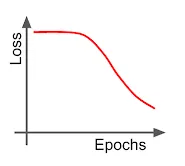
What is the most likely issue for not having a convergent (or near-maximally low) training loss?
- Not enough training time
- Overfit model
- Underfit model
- Too much training time
Implementation Strategies
Question 1
You deploy a trained model to your embedded system. The model gives us 4 outputs, each corresponding to the probability of each class. How do you identify the predicted class?
- Choose the class with probability over a threshold
- Sum the probabilities together and divide by 4
- Choose the class with the lowest probability score
- Choose the class with the highest probability score
Question 2
You wish to choose a threshold for your classification system, so you create 2 histograms on the same plot: one for the output probabilities of your target class when the input is your target class and another when the input class is not the target class. You get the following:
Which threshold should you choose if you want to minimize false negatives?
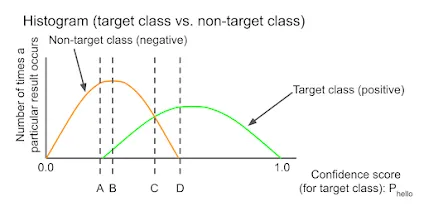
- A
- B
- C
- D
Question 3
You use the same validation dataset to evaluate 4 different models, which produce the ROC curves given below. Which model is likely to give you the best accuracy for your application?
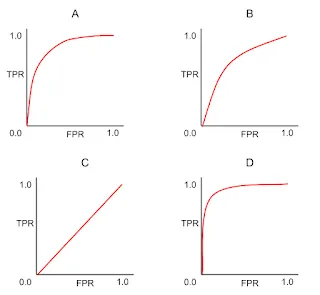
- A
- B
- C
- D
Question 4
A neural network (the ones we’ve looked at so far in the course) is probabilistic.
- True
- False
Question 5
In sensor fusion, all of the sensors must be the same type.
- True
- False
Implementation Strategies
Question 1
Audio classification can be used to detect anomalies in machinery.
- True
- False
Question 2
Your audio classification system samples at a rate of 16 kHz. Your target sounds should be at most what frequency?
- 16 kHz
- 4 kHz
- 8 kHz
- 32 kHz
Question 3
The collection of slices of Mel-frequency cepstral coefficients (MFCCs) describe how the frequencies in audio data change over time.
- True
- False
Question 4
A convolutional neural network (CNN) uses a fully-connected neural network to perform classification before performing convolution.
- True
- False
Question 5
Convolution layers in a convolutional neural network (CNN) perform feature extraction.
- True
- False
Question 6
You plot the training loss over the entire training period, and you discover the graph appears as follows:
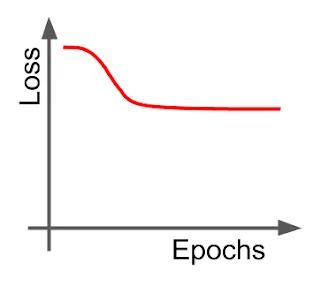
The model is not as accurate as you require (i.e. it is underfit to the data). Which of the following are likely to help you get a more accurate model? Select all that apply.
- Increase model complexity
- Gather more data
- Train for longer
- Early stopping
Question 7
You plot the training loss over the entire training period, and you discover the graph appears as follows:
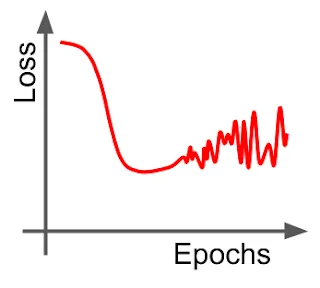
What is the most likely issue for having a divergent training loss over time?
- Overfit model
- Underfit model
- Learning rate is too low
- Learning rate is too high
Question 8
You wish to choose a threshold for your classification system, so you create 2 histograms on the same plot: one for the output probabilities of your target class when the input is your target class and another when the input class is not the target class. You get the following:
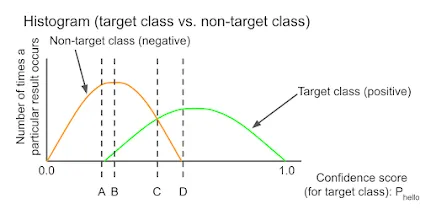
Which threshold should you choose if you want to minimize both false positives and false negatives equally (as best as possible)?
- A
- B
- C
- D
Question 9
Sensor fusion is a form of machine learning.
- True
- False
